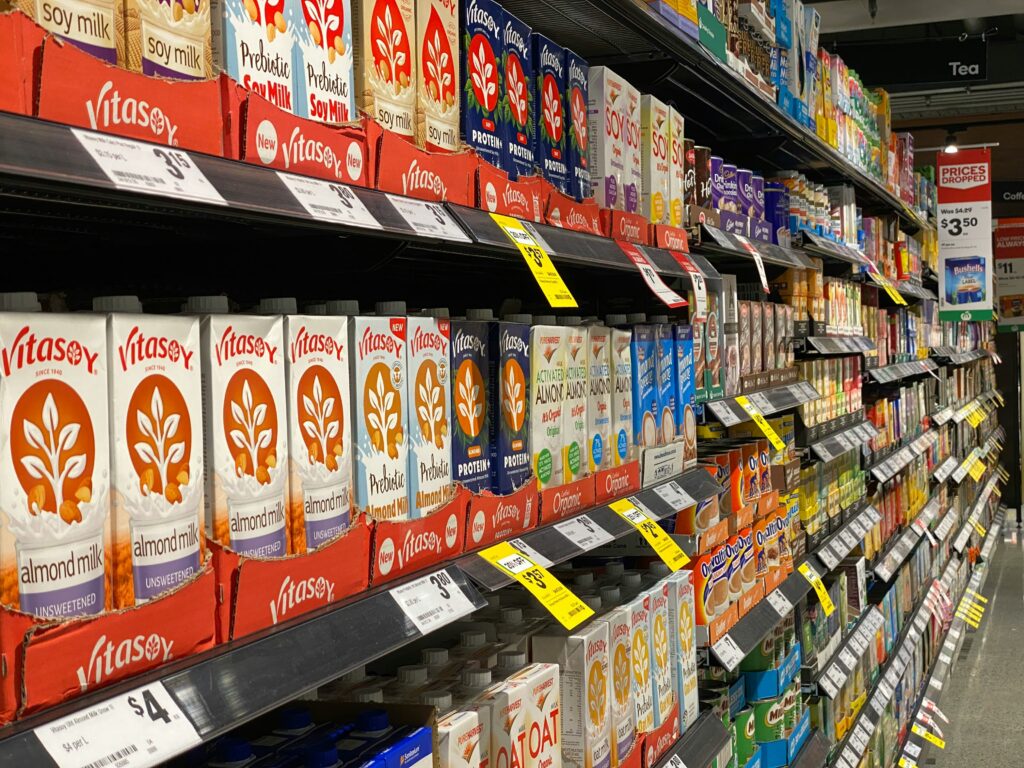We unpick the opportunities offered by plant-based price parity
Achieving price parity between plant-based and animal-based foods in retail has the potential to significantly impact the food industry. If plant-based and animal-based products were priced equally, it would be a win-win for producers/brands, retailers, consumers, and the overall plant-based market.
This article examines the economic implications, potential market shifts, consumer behaviors, and industry dynamics that could result from more competitive pricing of plant-based products. Though we will offer actionable insights for stakeholders across the food industry, these will be geared towards retailers and brands, with follow-up articles to come.
Understanding price parity
Plant-based options are currently priced at a premium compared to animal-based products. While the gap is smaller for more developed categories like milk and butter, plant-based meat remains high. Nielsen data demonstrates that, on average, plant-based meat is twice as expensive as beef, more than four times as expensive as chicken, and more than three times as expensive as pork per pound. For example, Beyond Meat’s Beyond Burger retails at £19.03 per kg, compared to Tesco’s premium own-label beef burger, which retails at £8.81 per kg!1
Why is this? Price is influenced by several, complex cost drivers:
- Channel costs and margins
- Production and packaging
- Logistics
- Selling
- Materials and ingredients
- Volume/economies of scale
- R&D
These factors interact in numerous ways to influence cost, but ultimately, the final price that shoppers pay is determined by the brand and retail outlets that sell it. Some retailers have made it a priority to reduce the price of the plant-based products they stock and are reaping the benefits (as we’ll demonstrate later), while others have chosen to prioritize high margins.
High margins
Worldwide, there are issues of high retail margins for plant-based products. Retailers, especially, are pricing plant-based products too highly – with margins of 35-50% typical across Europe (compared to 8% for animal-based meat products).2
The old wisdom says high prices can offset the low turnover of slow-moving stock. Some retailers believe they need high margins on plant-based products to offset wastage risk. But that logic is circular – rotation is low because of over-pricing.

Manufacturers are calling on retailers and brands to lower their margins to make plant-based alternatives more accessible to the mainstream. “We push our private label customers not to charge too high on the main market,” explains Frank Giezen, Co-founder of major European manufacturer Ojah. “This indirectly puts pressure on the brands to lower their prices too.”
Almost 40% of European consumers now identify as either vegan, vegetarian, pescatarian, or flexitarian. This means that there’s a huge total addressable market. By reducing retail margins and lowering prices, businesses can attract more of the flexitarian mass market and increase turnover.
However, retailers don’t want to portray plant-based products as cheap (even though they are generally cheaper to produce compared to meat and dairy products). And rightly so, agrees food consultant Jack Bobo of Futurity Foods: “I don’t know anybody who wants cheap food. I know people who want quality food at affordable prices. […] The language of cheapness undermines your product – it turns it into a commodity […] When it comes to psychology, they should be talking about quality and affordability.”
The experts we’ve spoken to are unanimous in this regard: they’re calling for plant-based foods to be presented as high-quality products (a matter of language) at affordable prices (a matter of margins).
Inflation and price hikes
The current economic landscape, marked by inflation and a cost-of-living crisis, has exacerbated price disparities between animal-based and plant-based foods. In 2023, US food-at-home prices were 5% higher than in 2022, with plant-based food prices increasing by 8% in 2023 and 18% compared to 2021. Similar trends are observed in Europe, challenging the affordability of plant-based products and pushing flexitarian consumers towards cheaper animal-based options.

In ProVeg’s 2021 survey on price parity, the majority (67%) of respondents said that when there is an increase in living costs, they prioritize saving money over making ethical decisions. 40% of consumers stated that an increase in their cost of living has led to them cutting down on plant-based foods and purchasing fewer of these products.
Price is a barrier for consumers
In the recent Smart Protein Project consumer survey, 38% of European respondents cited price as the most significant obstacle to purchasing plant-based alternatives, followed by taste (30%). Likewise, a Mintel study found that 20% of adults who do not currently consume meat alternatives point to high prices as a barrier.3 For those eating plant-based proteins less often than they did previously, more than a quarter (26%) of consumers state that affordability is the reason.4
Only when the price is right:
- 31% of consumers would only purchase plant-based options if they were lower in price than animal-based products
- Only 5% of consumers would pay ‘much more’ (the current price gap) for plant-based products than animal-based options
- 29% of European consumers stated they would not pay a higher price for plant-based products compared to animal-based products (even if they matched in taste and texture)5
“You’ll buy the product once based on novelty, you’ll come back if the taste was good and if there are benefits such as nutrition and sustainability, and you’ll buy it in the long run if the value is right.”
To ensure they remain accessible to consumers and compete with conventional products, alternative proteins must achieve levels of affordability that unlock the largest market – flexitarians (or mixed-eaters). As producers increasingly scale up production, achieve economies of scale, and seek price parity with conventional products/competitors, we anticipate the price gap shrinking, but this also depends on retailers playing their part.
Economic implications: what would happen if price parity was reached?
If plant-based products reach price parity with animal-based products, the potential growth in and out of the plant-based sector could be substantial, with various economic benefits.
What could happen to the plant-based industry?
Increased consumer adoption and broader consumer base:
As we’ve discussed, a significant barrier to the adoption of plant-based products is their higher cost compared to animal-based products. Price parity would reduce this barrier, increasing uptake among cost-conscious consumers. If price parity is achieved, some projections indicate the market could reach $74.2 billion by 2027, growing at a compound annual growth rate (CAGR) of over 11%.6
With plant-based products becoming more affordable, a wider segment of consumers is likely to purchase them. This includes not only vegetarians and vegans but also flexitarians and omnivores looking to reduce meat consumption.

Evidence of this was found in ProVeg’s 2021 survey on price parity. Consumers were more likely to select plant-based burgers at lower prices than their meat equivalent. The price decrease also appeared to bring additional customers into the sector and reduce demand for beef burgers. A price reduction from £6 to £2 for plant-based burgers, making them £1 cheaper than the animal-based option on offer, increased the likelihood of choosing plant-based burgers by a significant 134% and decreased the likelihood of selecting beef burgers by 14%.
Market size expansion:
The plant-based sector could capture a larger share of the food market by reaching price parity with animal-based products. Current estimates suggest that plant-based foods could grow from a niche market to a more mainstream one, potentially reaching a double-digit market share. As demand grows, companies would likely expand their product lines, offering a wider variety of plant-based options, further driving market expansion.
Investment, innovation and economies of scale:
Price parity could attract more investment into the plant-based sector, fostering innovation and leading to better, more varied products. Higher demand would also enable manufacturers to achieve economies of scale, further reducing production costs and enhancing profitability.
What’s in it for retailers?
Increased sales and revenue:
If plant-based products were more affordable, data shows that more consumers would be likely to purchase them. This would result in increased sales of plant-based products for retailers, pushing up overall revenues.
Offering a greater number of more affordable plant-based products can also increase the average basket size, as consumers might purchase additional items to complement their plant-based choices.
Case study: Price parity in practice at Lidl Germany
In October 2023, Lidl Germany announced that it would be bringing down the costs of all plant-based products from its own-brand Vemondo range to match their animal-based equivalents. Nearly nine months on, Lidl reported that plant-based sales have risen by more than 30%, with positive feedback from customers.

“We’ve seen a really positive sales and volume uplift since announcing the commitment.”
Lidl’s initiative sent shockwaves through the European retail sector, with numerous other supermarkets following suit in and out of Germany. Since Lidl Germany’s announcement, Lidl Belgium, Austria, Hungary, Denmark, and Luxemburg have also adopted the price parity pledge. Likewise, Germany’s Kaufland, Penny, Aldi Süd; Dutch chain Jumbo, and Austria’s BILLA, have announced similar price parity initiatives.
“Proteins are essential for our well-being, whether they are of animal or vegetable origin. Vegetable proteins have a positive impact on both people and the environment. By lowering the prices of the plant-based alternatives to the same level as the animal variant, we want the customer to be able to choose a plant-based alternative more easily.”
Competitive advantage:
Retailers offering a robust selection of affordable plant-based products can differentiate themselves in the market, attracting customers prioritizing sustainability, health, and ethical consumption.

Likewise, providing plant-based options at an acceptable price can enhance customer satisfaction and loyalty, especially among the growing demographic of health-conscious and environmentally aware consumers seeking these options.
Brand image and corporate social responsibility (CSR):
By prioritizing affordable plant-based products, retailers can enhance their reputation as environmentally responsible businesses, appealing to eco-conscious consumers. Retailers can also position themselves as advocates for healthier lifestyles, which can improve public perception and align with broader health and wellness trends.
Actionable insights
How can we optimize plant-based sales in this landscape and work towards price parity in retail? ProVeg makes the following recommendations for retailers and brands:
For Retailers:
- Lower margins for plant-based products:
- Reduce retail margins on plant-based products to attract the flexitarian market, which constitutes 30% of Europe. This can drive higher turnover and increase overall revenue through greater volume sales. ProVeg recommends a maximum retail margin of 15% for plant-based products. You can phase this in with long-term discount days, like Carrefour Belgium’s 20% discount on ’Veggie Thursdays’. If you want to be a market leader, you can introduce permanent price-parity across your plant-based and animal-based ranges, as Lidl did in Germany.
- Communicate product value:
- Clearly communicate the benefits of plant-based products, such as health advantages, environmental impact, animal welfare, and great taste. This transparency can justify the price and enhance consumer willingness to pay.
- Introduce private label options:
- Offer private-label plant-based products, which are often more affordable than branded options. This strategy can increase accessibility, drive consumer adoption, and help shift the perception of plant-based proteins as being too expensive.
- Implement long-term discounts:
- Provide long-term discounts on plant-based products to influence consumer behavior. Regular deep discounts can draw attention to plant-based ranges and give consumers time to adjust to new tastes and textures, ultimately boosting product turnover.
- Engage in active promotion:
- Use product samplings, end-of-aisle promotions, and targeted marketing campaigns to raise awareness and interest in plant-based products. This can help consumers become familiar with and more likely to purchase these products.
- Negotiate better terms with manufacturers:
- Leverage increased volumes of plant-based products to negotiate better margins and fees with manufacturers. This can be achieved by committing to larger purchase volumes and long-term contracts, providing manufacturers with stability and encouraging them to lower prices.
- Optimize supply chain and logistics:
- Collaborate with plant-based brands to optimize transportation and distribution processes. Pool resources and utilize shared logistics networks to reduce per-unit transportation costs.
- Promote volume sales:
- Implement marketing campaigns and promotions to drive higher volumes of plant-based product sales. This can include bundling products, offering discounts for bulk purchases, and cross-promotions with complementary products.
- Expand retail space for plant-based products:
- Dedicate more shelf space to plant-based products to increase their visibility and attract more customers. This can help drive higher sales volumes, which in turn can lead to better bargaining power with manufacturers.
- Collaborate on data-driven insights:
- Work with plant-based brands to share sales and customer data. This collaboration can help identify trends and opportunities for optimizing product assortments, pricing strategies, and promotional efforts.
For Brands:
- Scale-up production:
- Invest in expanding production capacity to achieve economies of scale. This includes optimizing production processes, improving facility designs, and increasing automation to lower per-unit costs.
- Innovate ingredient sourcing:
- Focus on securing cost-effective, high-quality ingredients by developing novel protein sources and improving crop yields. Collaborate with suppliers to drive innovation in ingredient production and processing.
- Enhance packaging efficiency:
- Streamline packaging processes to reduce costs. This can include using sustainable packaging materials, optimizing packaging designs, and negotiating better rates with packaging suppliers.
- Invest in R&D:
- Continuously invest in research and development to improve product formulations, enhance taste and texture, and reduce production costs. Focus on developing scalable production technologies and processes.
- Optimize marketing and SG&A expenses:
- Efficiently manage marketing and administrative expenses by leveraging digital marketing strategies, targeted advertising, and data analytics to reach potential customers effectively. Scale-up marketing efforts proportionately to sales growth to keep costs in check.
- Collaborate with retailers:
- Work closely with retailers to align on pricing strategies, promotions, and product placement. Share market insights and collaborate on joint marketing initiatives to drive consumer adoption of plant-based products.
- Utilize shared supply chains:
- Engage in co-manufacturing and pooled procurement with other plant-based brands to benefit from shared supply chain efficiencies. This can help reduce production, transportation, and procurement costs.
- Focus on localized production:
- Develop localized production facilities to minimize transportation costs and improve supply chain resilience. This can also appeal to consumers who prioritize locally sourced products.
- Transparent pricing communication:
- Clearly explain to consumers how product prices are determined, especially if they contain high-quality or costly ingredients. Transparent communication can build trust and make consumers more willing to pay the set prices.
- Lobby for tax and subsidy reform:
- Advocate for policy changes that reduce subsidies for animal agriculture and provide support for plant-based alternatives. This can help level the playing field and make plant-based products more competitively priced.
- Foster long-term partnerships:
- Build long-term partnerships with specialized ingredient manufacturers and suppliers to drive down costs. For example, work with companies focused on reducing the cost of plant-based proteins through technological innovations and scaling up production.
Get in touch with ProVeg’s team of experts for more support on your alternative protein strategy at [email protected].
References
- Plant based meats – the battle for price parity, (2024). New Food Innovation. Available at: https://www.new-foodinnovation.co.uk/price-parity. Access 2024-05-29.
- Insights from ProVeg International interviews with four major European manufacturers and retailers, September to November 2021.
- US plant-based proteins report, (2023). Mintel. Available at: https://store.mintel.com/report/us-plant-based-proteins-market-report. Accessed 2024-05-29.
- US plant-based proteins report, (2023). Mintel. Available at: https://store.mintel.com/report/us-plant-based-proteins-market-report. Accessed 2024-05-29.
- What consumers want: a survey on European consumer attitudes towards plant-based foods, (2021). ProVeg International and the Smart Protein Project. Available at: What Consumers Want | ProVeg International. Accessed 2024-05-28.
- Plant-based food market, (2024). Meticulous Research. Available at: Accessed 2024-06-04.



